Are you looking for a way to boost your health and energy levels naturally?
Imagine foods so rich in nutrients that they can improve your overall well-being with every bite. These aren’t just any foods – they are superfoods, the powerhouses of nutrition.
Superfoods are more than just a trendy buzzword. They are scientifically proven to offer a multitude of health benefits.
Want to know what makes them so unique?
In this blog, we will explore what makes a food a ‘superfood,’ examine the science behind its health benefits, highlight some of the most potent Indian superfoods you can incorporate into your diet, and provide tips on how to enjoy them in your daily meals.
Table of Contents
What Are Superfoods?
Superfoods are a group of nutrient-rich natural foods considered particularly beneficial for human health. They are thought to be superior sources of antioxidants, vitamins, and minerals – elements that help our bodies ward off diseases and live longer healthier lives.
These foods have become popular for their potential to lessen the occurrence of chronic diseases such as heart disease and diabetes. Superfoods like blueberries, spinach, and salmon are praised for their high levels of powerful antioxidants, omega-3 fatty acids, and fiber – all crucial for maintaining a balanced diet and reducing oxidative stress.
The spotlight on superfoods is not without reason. Regular consumption of these nutrient-packed items has been associated with reduced blood pressure, improved blood sugar levels, and even a reduced risk of certain types of cancers.
Are They Worth The Hype?
Superfoods are not just a modern phenomenon; they have played a pivotal role in traditional diets around the globe. Their time-tested health benefits make them integral to maintaining a balanced and wholesome diet. Loaded with flavours and health benefits, here are a few of the best Indian superfoods that are not just culinary staples but also powerful allies to boost your overall well-being.
Top 10 Indian Superfoods List
| 1. Amla or Indian Gooseberry |
| 2. Turmeric |
| 3. Moringa |
| 4. Desi Ghee or Clarified Butter |
| 5. Tulsi or Holy Basil |
| 6. Makhana or Foxnuts |
| 7. Flaxseed or Alsi |
| 8. Bajra or Pearl Millet |
| 9. Ginger |
| 10. Fenugreek or Methi |
Amla
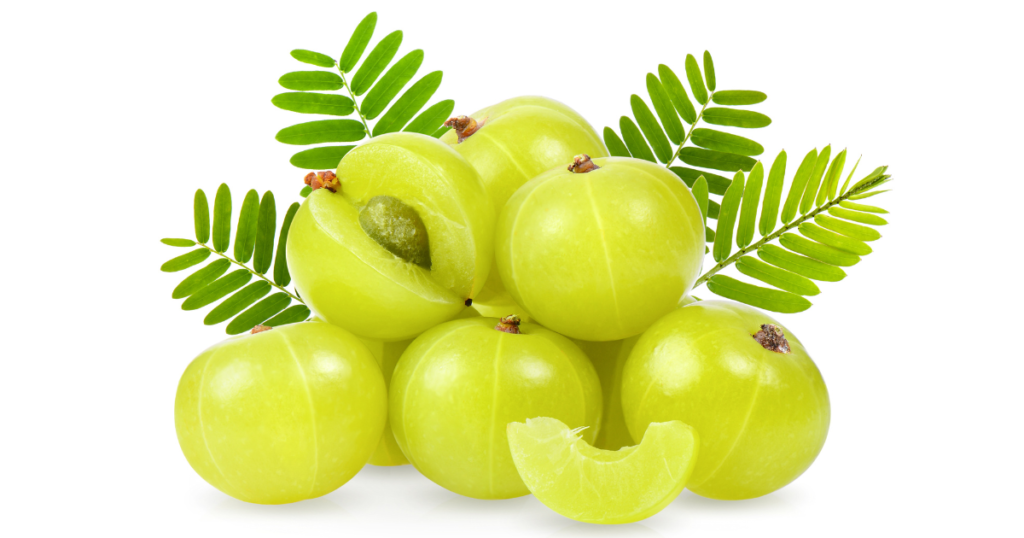
Also revered as Indian Gooseberry, amla is a small fruit packed with an astonishing blend of nutrients, making it worthy of one of the best Indian superfoods title. This sour berry is native to India and a staple in Ayurvedic medicine, where it’s touted for its health-promoting properties.
Health Benefits of Indian Gooseberries/Amla
Indian Gooseberries are a potent source of vitamin C, which not only bolsters the immune system but also contains antioxidant properties that can mitigate oxidative stress and lower the risk of diseases, including some types of cancers1. Their nutritional profile includes a range of polyphenols, which are known to have protective effects against various health issues.
The benefits of Amla are wide-ranging:
- They may help reduce the risk of heart disease by improving cholesterol levels and blood pressure.
- Amla supports liver health and can aid in detoxifying the body.
- Regular consumption of amla may aid in controlling blood sugar levels, beneficial for those managing diabetes.
- The high fiber content in amla assists in digestion and can contribute to a healthy gut.
With its dense nutritional content, amla contributes to maintaining a balanced diet and is considered a support for healthy ageing due to its powerful antioxidant capacity.
Tips to Add Amla Into Your Diet
Amlas can be an intriguing new addition to your diet, and here are simple ways to enjoy this incredible superfood:
- Fresh amla can be eaten raw, but its sour taste may not be for everyone. If you’re feeling adventurous, sprinkle a bit of pink or black salt to enhance its flavour.
- Dried Indian Gooseberries are a more palatable option for those new to the fruit. They can be snacked on throughout the day.
- Amla juice is a concentrated way to take in the benefits and can be a refreshing morning beverage.
- Indian Gooseberry powder can be mixed into drinks or smoothies or even used as a spice in cooking.
With these methods, anyone can enjoy the health benefits of amla as part of a diverse and nutritious diet. As with any new addition to your diet, start with small portions to ensure your body adapts to the new food.
Turmeric
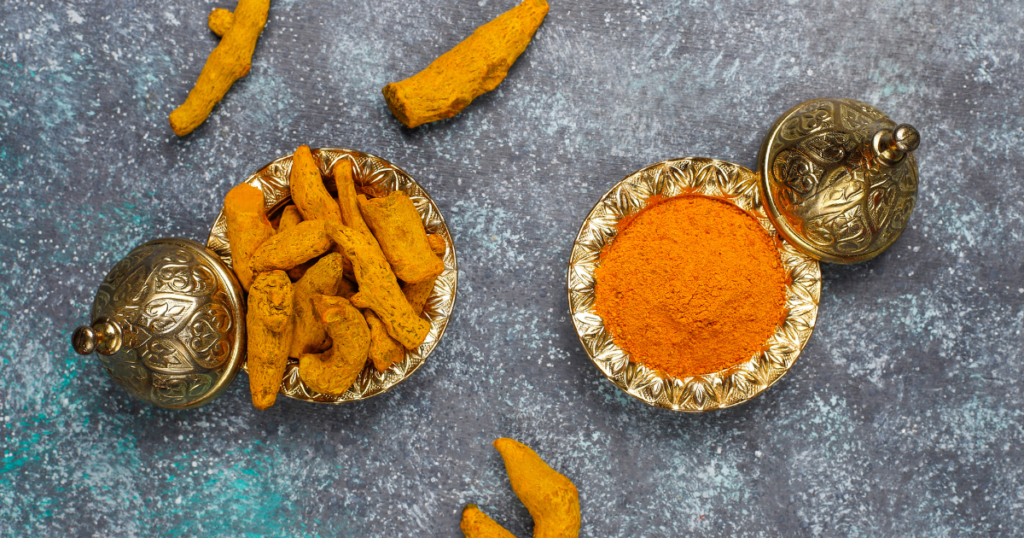
Turmeric is a golden-yellow spice that has been revered for centuries as both a culinary ingredient and a medicinal herb. Originating from India, turmeric is a staple in traditional medicinal systems, such as Ayurveda, due to its primary active compound, curcumin. Modern research substantiates ancient wisdom by recognizing its potent anti-inflammatory and antioxidant effects.
Notably, turmeric’s curcumin has a low bioavailability on its own, which means it’s difficult for the body to absorb effectively. However, combining it with black pepper, which contains piperine, can enhance absorption significantly by 2000%2.
Health Benefits of Turmeric
The health benefits of turmeric are extensive and impactful. One of its most prominent advantages is in mitigating the risk of chronic diseases, which is attributed to the anti-inflammatory properties of curcumin. Chronic inflammation is a common factor in many health conditions, and by curbing inflammation, turmeric helps protect against various health challenges.
Research suggests that turmeric may also be instrumental in improving blood sugar levels, thereby offering benefits to those managing diabetes. Additionally, its antioxidant properties may help reduce the oxidative stress linked to ageing and many chronic diseases. There is also evidence pointing towards turmeric’s potential in supporting brain health and functioning, which includes mood regulation and protecting against age-related cognitive decline3.
Furthermore, curcumin has been studied for its effects on cardiovascular health, where it may help maintain healthy blood pressure levels and improve endothelial function. Its potential anti-cancer properties are also being explored, with studies suggesting it might play a role in reducing the growth of cancer cells and deterring the spread of tumours. With such an impressive repertoire, turmeric is a superfood that stands out in the quest for a nourishing, health-boosting diet.
Tips To Add Turmeric Into Your Diet
Incorporating turmeric into your diet doesn’t require complex skills, and here are some simple yet effective ways to do so:
- Add a pinch of turmeric to your morning smoothie for a subtle earthy flavour.
- Sprinkle turmeric into rice, quinoa, or any grain dish for an extra nutrient punch.
- Use it to season vegetables before roasting, it pairs well with cauliflower, potatoes, and greens.
- Brew turmeric tea or golden milk, a comforting beverage made with milk, honey, and a dash of turmeric.
- Include it in your soup and stew recipes to give them a vibrant hue and a burst of health benefits.
- When making curries or stir-fries, incorporate a spoonful of turmeric for an authentic taste and nutrient boost.
Remember, when using turmeric, a little often goes a long way. And don’t forget to add a pinch of black pepper to any turmeric-infused dish to enhance the absorption of curcumin. Through these simple integrations, turmeric can easily become a healthful mainstay in your daily meal planning.
Moringa
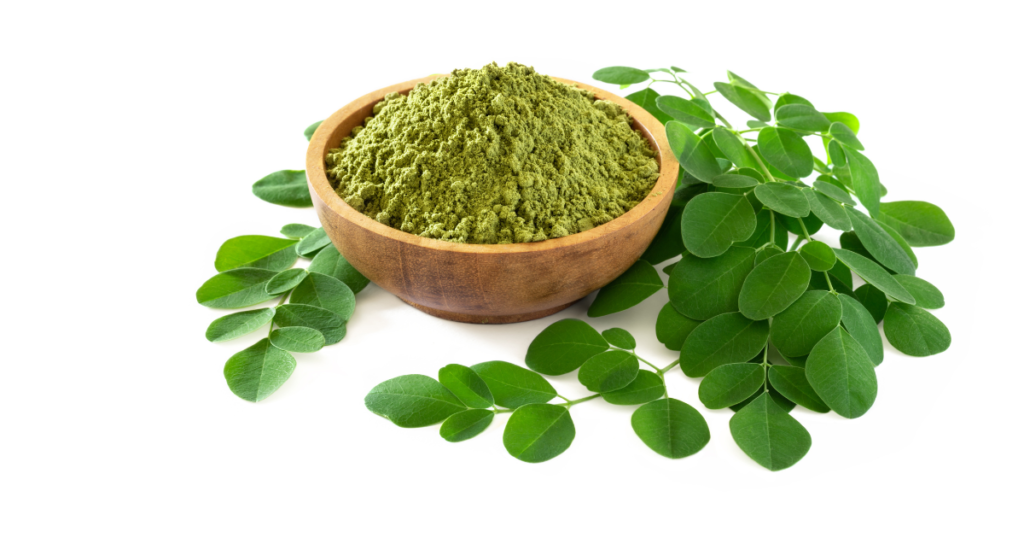
Moringa, often referred to as the “Miracle Tree,” is a nutritional powerhouse. Largely cultivated in tropical and subtropical regions around the globe, moringa is a plant that is renowned not only for its diverse uses in traditional medicine but also for its remarkable concentration of healthy compounds. Its leaves, seeds, and roots contain a treasure of vitamins, minerals, and antioxidants, making it a much-celebrated superfood in the health and wellness community.
Health Benefits of Moringa
Moringa leaves are teeming with health-promoting attributes, which include:
- Immune System Support: Rich in vitamin C, it fortifies the immune system.
- Anti-Inflammatory Effects: Isothiocyanates in moringa help reduce inflammation.
- Nutrient-Dense: A remarkable source of vitamins A and E, calcium, and iron.
- Healthy Skin and Hair: It is high in antioxidants, promoting skin health and supporting hair growth.
- Energy Boost: Its iron and amino acids contribute to an increase in energy levels.
This nutritional dynamo is also celebrated for its potential in supporting the reduction of chronic diseases such as types of cancers, diabetes, liver disorders and hypertension4. Furthermore, it could play a role in balancing blood sugar levels and enduring the risk of cardiovascular diseases due to its high concentration of antioxidants and heart-healthy nutrients.
Tips To Add Moringa Into Your Diet
Incorporating moringa into your daily routine can be both simple and delicious. Here are a few suggestions:
- Tea: Steep dried moringa leaves in hot water for a nutritious tea.
- Smoothies: Add a spoonful of moringa powder to your morning smoothie for an extra nutrient kick.
- Seasoning: Sprinkle moringa powder over salads or use it as a seasoning in soups and stews.
- Supplement Capsules: For those on the go, moringa is available in capsule form.
- Cooking Greens: Fresh moringa leaves can be cooked similarly to spinach and incorporated into a vast array of dishes.
By integrating moringa into your diet, you are sure to reap the numerous health benefits it provides. Whether you are looking to enhance your nutritional intake, improve your overall health, or simply add some variety to your meals, moringa is an excellent source of essential nutrients and a valuable addition to a balanced and healthy diet.
Desi Ghee or Clarified Butter
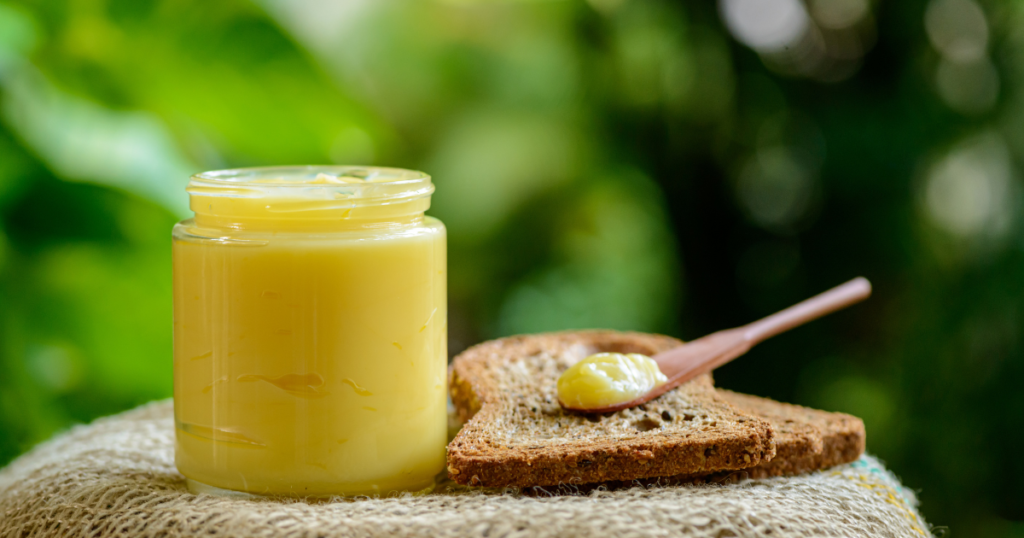
In the realm of traditional Indian cooking, Desi Ghee, also known as clarified butter, is a culinary staple that has transcended its roots to become recognized as a superfood in the health and wellness community. Desi Ghee is made from cow or buffalo milk and involves a process of simmering butter, which separates the milk solids from the liquid fat. The result is a pure combination of fats without any milk residue, granting it a high smoke point and a rich, nutty flavour that enhances the taste of various dishes.
Health Benefits of Desi Ghee or Clarified Butter
The advantages of incorporating Desi Ghee into your diet are numerous and contribute to overall well-being:
- Rich in Fat-Soluble Vitamins: Ghee is an excellent source of vitamins A, E, and D, which are crucial for maintaining good vision, a healthy immune system, and strong bones.
- Digestive Aid: Ghee has been shown to support the digestive system. It aids in the absorption of nutrients and may decrease inflammation in the gastrointestinal tract.
- Weight Management: Contrary to the misconceptions about fats, ghee contains medium-chain triglycerides (MCTs), which the body can burn quickly for energy, possibly supporting weight loss efforts.
- Heart Health: While ghee is high in saturated fats, consuming it in moderation has been linked to a lower risk of heart disease.
- Anti-Inflammatory Properties: The butyric acid found in ghee is known to combat inflammation in the body, which can reduce the risk of several chronic conditions.
It is important to consume ghee in moderation, as it is calorie-dense and excessive consumption could lead to adverse effects on health, particularly for those with certain health conditions.
Tips To Add Desi Ghee or Clarified Butter Into Your Diet
Desi Ghee’s versatility makes it a simple ingredient to integrate into your daily meals. Here are some delectably healthy ways to use it:
- Cooking and Frying: Thanks to its high smoke point, ghee is an ideal fat for sautéing, frying, and grilling without producing harmful free radicals.
- Spread on Bread: Swap out your butter or margarine with ghee as a delicious spread on toast or flatbreads.
- Baking: Replace oils or butter with ghee for a richer flavour in your baked goods.
- Rice and Vegetables: A teaspoon of ghee mixed into rice or over steamed vegetables can add a sumptuous depth of flavour.
- Bulletproof Coffee: Blend a spoonful of ghee into your coffee for an energizing, keto-friendly start to your day.
In summary, Desi Ghee is a nourishing fat that, when used judiciously, can enhance your diet with its unique health benefits and flavour profile. Whether cooking up a storm or simply looking for a healthier alternative to common fats, ghee is a valuable superfood worth incorporating into a balanced diet.
Tulsi or Holy Basil

Tulsi, also known as Holy Basil, is a revered plant in India, where it is an integral part of both culinary tradition and religious ceremonies. As a superfood, Tulsi leaves are cherished not only for their aromatic fragrance but also for the profound impact they have had on human health through the ages. Scientifically known as Ocimum sanctum, Tulsi comes with an impressive profile of phytonutrients and has been a staple in Ayurvedic medicine for centuries.
Health Benefits of Tulsi or Holy Basil
The health benefits of Tulsi are vast and well-documented. The plant is a powerhouse of potent compounds that contribute to its status as one of the best Indian superfoods. Some of the key benefits include:
- Stress Reduction: Tulsi is known as an adaptogen, which means it aids in lowering stress levels in the body. It helps balance cortisol levels and promotes mental clarity.
- Immune Support: It has immunomodulatory properties that can help boost your immune system and protect from infections.
- Anti-inflammatory Properties: The eugenol and other essential oils found in Tulsi have strong anti-inflammatory effects, which are beneficial for managing inflammatory conditions like arthritis.
- Antioxidant Activity: With its potent antioxidant properties, Tulsi helps reduce oxidative stress, protecting the body from free radical damage and may help reduce the risk of health disorders, including certain types of cancers.
- Heart Health: Regular intake of Tulsi has been linked to better heart health, as it can help lower blood pressure and cholesterol levels, thus boosting the heart health.
- Blood Sugar Management: Tulsi can help regulate blood sugar levels, making it excellent for those with diabetes or pre-diabetes.
- Respiratory Benefits: It supports respiratory system health and can be particularly helpful during conditions like bronchitis and asthma.
Tips To Add Tulsi or Holy Basil Into Your Diet
Incorporating Tulsi into your diet can be both simple and enjoyable. Here are a few ways to relish the benefits of this superfood:
- Tea: One of the effortless ways to consume Tulsi is by brewing it in hot tea. You can combine it with other herbs and spices for a refreshing and therapeutic beverage.
- Fresh Leaves: Add fresh Tulsi leaves to salads for a peppery kick, or use it in place of other basil varieties in pesto.
- Dried Leaves: Sprinkle dried Tulsi leaves over your dishes as a seasoning or add them to soups for added health benefits.
- Supplements: Tulsi is available in capsule or tincture form for those who prefer a more concentrated and convenient intake.
- Chewing the Leaves: Simply chewing on a few Tulsi leaves every day can give you a quick and potent dose of its goodness.
Adding Tulsi to a daily routine can bring a taste of the exotic alongside a wealth of health benefits, supporting a diverse and balanced diet for improved well-being. Whether included as a therapeutic tea or as a striking flavour addition to meals, Tulsi or Holy Basil stands as a paradigm of healthful and nourishing superfoods.
Makhana or Foxnuts
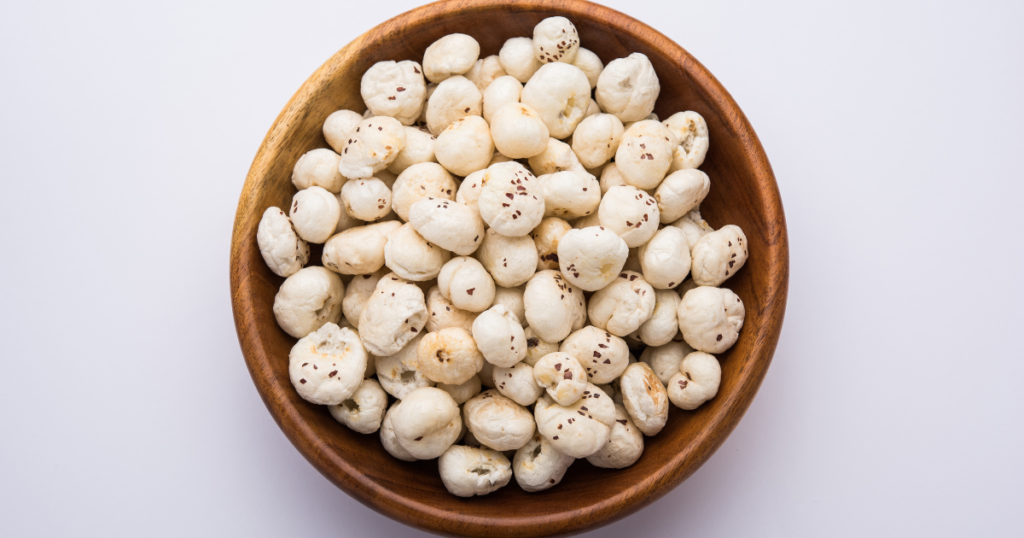
Makhana, commonly known as foxnuts or lotus seeds, is a superstar within the realm of Indian superfoods. These puffy, popcorn-like kernels have an exceptional nutritional profile, which renders them not just a snack of choice but also a compelling ingredient for a healthy diet.
Health Benefits of Makhana or Foxnuts
Makhanas are celebrated for their numerous health benefits, making them an excellent source of nourishment for various bodily needs:
- Protein Source: As a source of plant protein, they are especially advantageous for vegetarians and vegans looking to augment their protein intake.
- Heart Health: Their low sodium and high magnesium content can contribute significantly to cardiovascular health by aiding in the management of blood pressure.
- Weight Management: Low in calories yet high in dietary fiber, makhanas make a satiating snack that can help in weight loss or maintenance without compromising nutritional intake.
- Anti-Aging Properties: The presence of powerful antioxidants in makhanas assists in combating oxidative stress, reducing signs of ageing, and potentially lowering the risk of chronic diseases.
- Diabetes-Friendly: The low glycemic index of foxnuts makes them a suitable snack for stabilizing blood sugar levels.
- Bone Health: They contain calcium, which we need for maintaining strong bones and teeth.
- Improved Digestive Health: The fiber in makhanas aids in digestion and helps prevent constipation.
Tips To Add Makhana or Foxnuts Into Your Diet
Incorporating makhanas into your diet is surprisingly easy and versatile. Here are several delightful ways you can enjoy this superfood:
- Roasted Snack: Simply roast dry makhanas in a pan, add a pinch of salt, and you have a crunchy, healthy snack.
- With Milk: Boil makhanas in milk until soft. Sweeten with honey or a natural sweetener for a healthy pudding alternative.
- In Soups and Salads: Toss them into soups or salads for an added crunch and protein boost.
- Makhana Butter: Blend toasted makhanas until smooth and use as a spread on toast or in smoothies.
- Flavoured Varieties: Experiment with different seasonings, such as turmeric, pepper, or herbs, to make flavoured makhanas that cater to your palate.
- Desserts: Ground makhana can be used as a gluten-free flour alternative in desserts like cookies or pancakes.
By adding makhana into your eating habits, you’re not just pampering yourself with a tasty snack; you’re also enriching your body with essential nutrients. With its varied use in both savoury and sweet dishes, makhana is a nutritious substitute that aligns well with a balanced diet and is a promising ally against numerous health concerns, including the risk of heart disease and diabetes.
Alsi or Flaxseeds
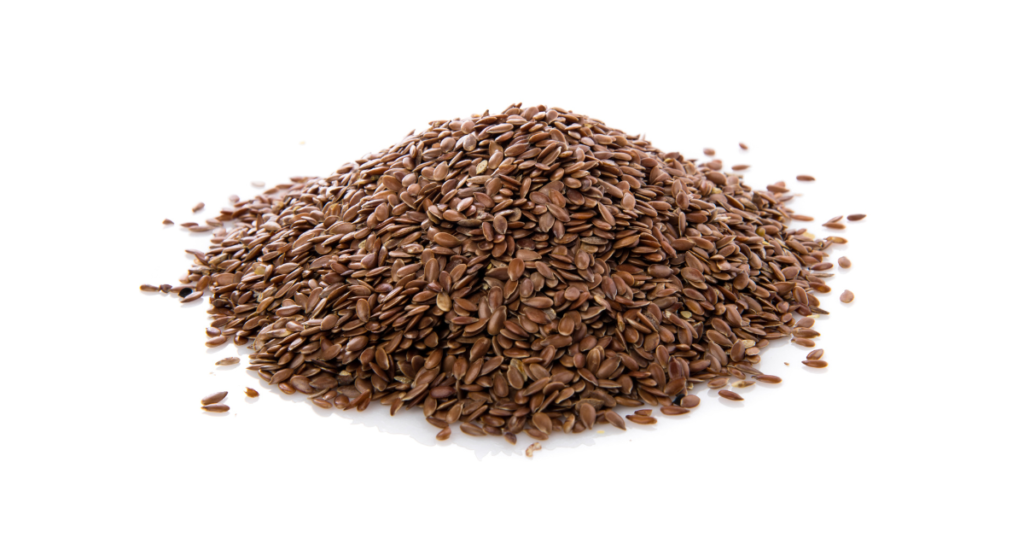
Flaxseeds, derived from the Linum usitatissimum plant, are renowned for their rich content of dietary fiber, antioxidants, and alpha-linolenic acid—an essential omega-3 fatty acid. With their nutty flavour, they are a popular addition to various diets, offering multiple health benefits, including the potential to reduce the risk of heart disease and improve digestive health.
Health Benefits of Flaxseeds
Flaxseeds, deriving from the Linum usitatissimum plant, are acclaimed for their nutritional properties and potential health benefits. Here are key points that highlight the health benefits of flaxseeds:
- Rich in Dietary Fiber: Flaxseeds contain both soluble and insoluble fiber, which promote digestive health, regular bowel movements and prevent constipation.
- High in Omega-3 Fatty Acids: Specifically rich in alpha-linolenic acid (ALA), flaxseeds can contribute to the reduction of the risk of heart disease and inflammation in the body.
- Contains Antioxidant Properties: The lignans found in flaxseeds possess antioxidant qualities that help protect against free radical damage, potentially reducing the risk of certain cancers like breast cancer.
- May Improve Cardiovascular Health: Regular flaxseed consumption has been linked to better blood pressure and cholesterol levels, according to several studies, thereby supporting heart health.
- Stabilizes Blood Sugar: The fiber in flaxseeds can help stabilize blood glucose levels, making them beneficial for those managing diabetes.
- Relief from Hot Flashes: Some studies suggest that dietary supplementation with flaxseeds can reduce the frequency or intensity of hot flashes in menopausal women.
Tips To Add Flaxseeds Into Your Diet
Flaxseeds, derived from Linum usitatissimum, have gained popularity for their nutrient-rich profile. Here’s how you can seamlessly incorporate them into your diet:
- Morning Boost: Mix ground flaxseeds with your morning yoghurt or cereal to inject a nutty flavour and a dose of dietary fiber that aids digestion and heart health.
- Blend it Up: Add flaxseed oil or whole seeds to your smoothies. The oil is rich in alpha-linolenic acid (ALA), contributing to the potential reduction of cardiovascular diseases.
- Baking Better: Substitute flaxseeds for a portion of flour in recipes for a healthful twist. They bring both texture and are a boon for digestive health.
- Salad Sprinkle: Top off your salads with a sprinkle of ground flaxseed for an antioxidant and fiber boost, and a subtle crunch that elevates every bite.
- Homemade Goodness: Incorporate flaxseeds into homemade bread, muffins, or cookies. Just grind them using a coffee grinder or food processor.
Remember, add flaxseeds gradually into your diet to adjust to the increased fiber intake and ensure to drink plenty of water. With their myriad health benefits, from lowering blood sugar levels to improving heart health, flaxseeds are a worthy addition to any diet. Incorporating ground flaxseed in moderate amount into your diet can enhance its nutritive absorption5.
Bajra or Pearl Millet
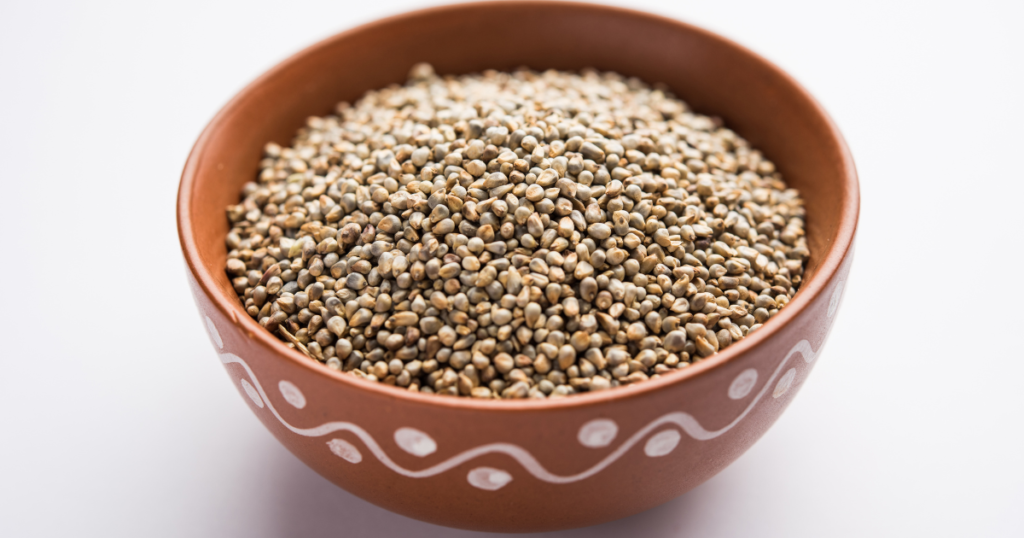
Bajra, also known as pearl millet, is a traditional grain that has been a staple in many parts of the world, particularly in India and Africa. Not only is it a source of sustenance for millions, but it’s also emerging as a modern superfood in the realm of nutrition-conscious communities globally.
Its slightly nutty flavour and versatile nature make it an excellent choice for anyone looking to enhance their diet. Packed with fiber, protein, and a slew of vitamins and minerals, bajra takes a prominent place at the table of health-forward foods, contributing to a well-rounded and healthy diet.
Health Benefits of Bajra or Pearl Millet
The health benefits of bajra are vast due to its rich nutritional profile. Here’s a look at some of its powerful advantages for human health:
- Rich in Fiber: Bajra is a great source of dietary fiber which aids in digestion and maintains regular bowel movements.
- Gluten-Free: As a gluten-free grain, it is superb for those with celiac disease or gluten sensitivity.
- Controls Blood Sugar Levels: Its low glycemic index helps in keeping blood sugar levels stable, proving beneficial for diabetics.
- Heart Health: The presence of magnesium in bajra can lead to improved circulation and lower blood pressure, and better heart health
- Iron-Rich: Being a good source of iron, it is beneficial in combating anaemia and boosting energy levels.
Additionally, it is notable that the phytochemicals present in bajra exhibit antioxidant properties, helping the body ward off oxidative stress and potentially lowering the risk of certain types of cancers.
Tips to Add Bajra or Pearl Millet Into Your Diet
Incorporating bajra into your diet is remarkably straightforward and allows for a good deal of creativity. Here are some ideas to get started:
- Porridge: Start your morning with a warm bowl of bajra porridge, sweetened with honey or jaggery.
- Roti or Flatbread: Replace wheat flour with bajra flour to make gluten-free rotis.
- Salads: Add cooked bajra grains to salads for a crunchy texture and a fiber boost.
- Soups and Stews: Throw in some bajra grains to hearty soups and stews for added thickness and nutrition.
- Snack: Puffed bajra can be eaten as a light snack, similar to popcorn.
Remember, when introducing bajra into your diet, it’s important to ensure you maintain a balanced intake of food, combining bajra with various other nutrients and food groups to ensure a well-rounded, healthy diet. With its versatility, bajra can easily become a go-to ingredient for anyone aiming to foster a nutritious and satisfying eating pattern.
Ginger
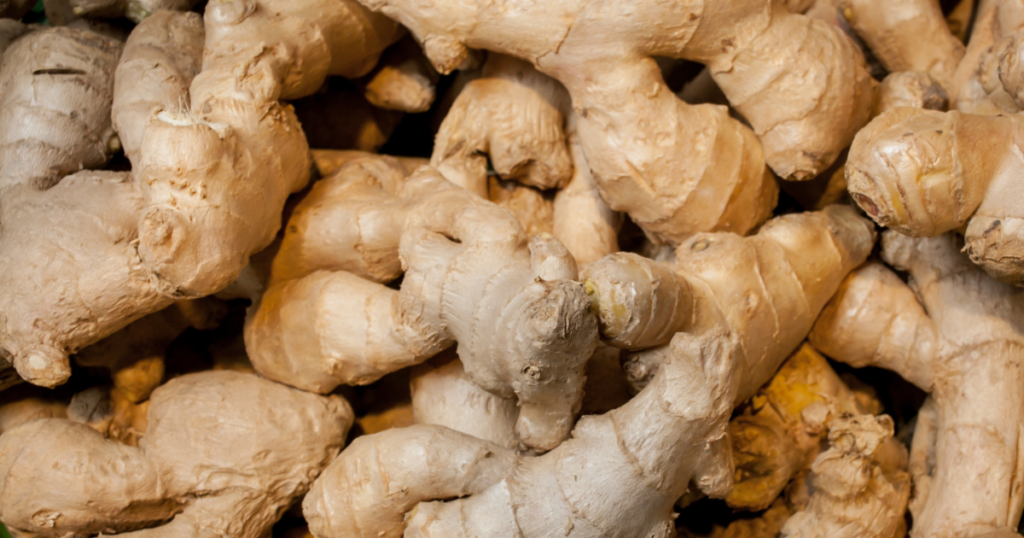
Ginger is a rhizome that’s been celebrated for its culinary and medicinal qualities for millennia across many cultures. This spicy, aromatic superfood is packed with bioactive compounds and nutrients that are vital for maintaining good health.
Health Benefits of Ginger
The health benefits associated with ginger are extensive and impressive. It contains gingerol, a substance with powerful antioxidant and anti-inflammatory properties. This can lead to risk reduction for various illnesses, including chronic diseases like heart disease, aiding in the management of blood pressure and cholesterol levels.
Ginger is also well-known for its positive effects on digestion and nausea relief, particularly morning sickness. Like turmeric, ginger may also protect against certain types of cancers due to its antioxidant properties.
Regular ginger consumption can also help in dealing with inflammatory conditions such as osteoarthritis. Plus, there’s growing evidence that ginger can aid in controlling blood sugar levels, contributing to diabetes management. All in all, ginger is a powerful superfood that can fortify the human health against numerous challenges.
Tips to Add Ginger Into Your Diet
Incorporating ginger into one’s diet is remarkably easy due to its versatility, here are just a few ways:
- Fresh ginger can be grated into stir-fries to add flavour to dishes.
- A slice of ginger can be added to tea for a warming and digestive-aid beverage.
- Ginger can also be juiced or mixed into smoothies for a zesty kick and a nutritional boost.
- Incorporate dried or powdered ginger into baked goods like cookies, cakes, or bread for a spicy note.
- Ginger can be pickled which can be added to salads for an Asian twist.
By making ginger a regular part of your meals or drinks, you can effortlessly enjoy its multitude of health benefits. Whether you’re aiming for quick relief from nausea or seeking to enrich your diet with potent antioxidants and anti-inflammatory compounds, ginger is an excellent addition to a well-balanced and nutritious diet.
Fenugreek or Methi
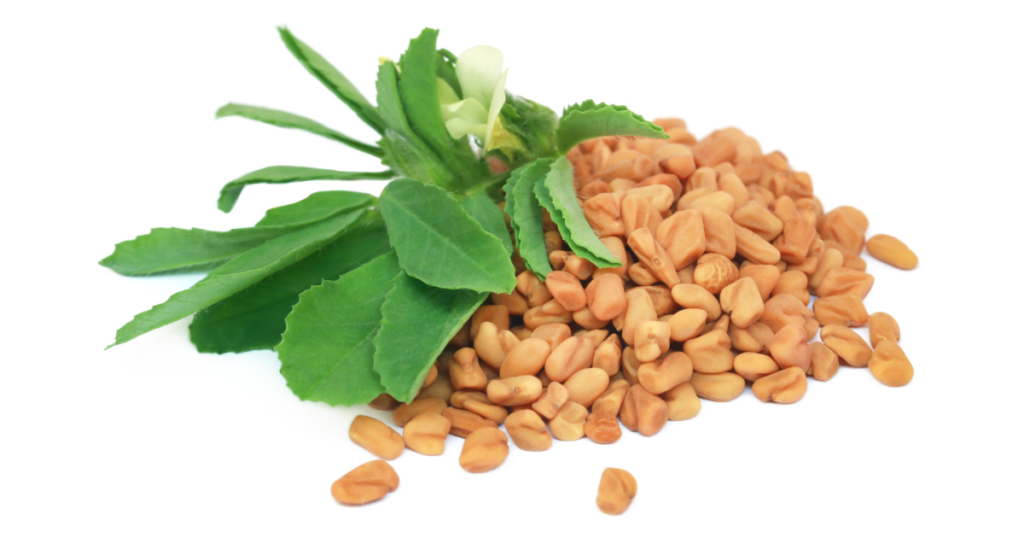
Fenugreek has carved a reputation not just as a flavour enhancer but also as a terrific superfood. The small, golden-brown methi seeds or its green leaves are loaded with nutrients and carry an array of health benefits.
Health Benefits of Fenugreek
Fenugreek seeds have been used traditionally to address a range of ailments and their health-boosting properties are increasingly backed by scientific research. Some of the key benefits include:
- Blood Sugar Regulation: Fenugreek has been associated with improved blood sugar control, making it a valuable dietary addition for those monitoring their glucose levels.
- Cholesterol Reduction: Consuming fenugreek may contribute to lower levels of cholesterol, which in turn can help reduce the risk of heart disease.
- Appetite Control: Its natural fiber content can promote a feeling of fullness, thus aiding in weight management by curbing overeating.
- Anti-inflammatory Effect: The presence of linolenic and linoleic acids, which are known for their anti-inflammatory properties, can be beneficial in managing symptoms of arthritis and other inflammatory conditions.
- Digestive Health: Rich in fiber, fenugreek helps maintain healthy digestion and relieve constipation.
- Women’s Health: Fenugreek has been traditionally used to alleviate menstrual cramps and symptoms associated with menopause due to its phytoestrogen content.
Tips to Add Fenugreek Into Your Diet
Incorporating fenugreek into your diet is easy and can be done in various delicious ways. Here are some suggestions:
- Tea: Add fenugreek seeds in hot water to make a calming tea.
- Spice Blends: Ground fenugreek can be added to spice mixes for marinades or curry powders.
- Salads: Sprouted fenugreek seeds can be tossed into a salad for a nutty flavor.
- Soups and Stews: The seeds can be used as a seasoning agent.
- Dough and Batters: Incorporate fenugreek leaves into doughs for flatbreads or mix into batter for a unique twist in baked goods.
Incorporating fenugreek into various aspects of your diet can enhance both the nutritional value and depth of flavour in your meals. This versatile superfood, whether in seed form or as dried leaves, aligns with a balanced diet that supports overall health and well-being.
Conclusion
Indian superfoods have gained popularity for their dense nutritional profiles and health benefits. They can significantly reduce the risk of heart disease, chronic diseases, and certain types of cancers thanks to their powerful antioxidants. These foods are often an excellent source of essential nutrients like fiber, omega-3 fatty acids, vitamins, and minerals.
Indian superfoods as a part of your daily diet can support health in multiple ways. For instance, leafy greens, berries, walnuts, chia seeds, millets, peanuts, etc. offer impressive antioxidant properties. Regular consumption of these foods can also help maintain blood pressure and blood sugar levels.
Incorporating these Indian superfoods into your daily nutrition can be part of a strategy to support a healthy lifestyle. Remember, no single food holds the key to good health; a holistic approach to your diet is always best.
Bonus Tip: Beetroot, ragi, almonds, coconut, ashwagandha, peanuts, and jackfruit also fall under the top Indian superfoods list.
Sources
- Kapoor, M. P., Suzuki, K., Derek, T., Ozeki, M., & Okubo, T. (2020). Clinical evaluation of Emblica Officinalis Gatertn (Amla) in healthy human subjects: Health benefits and safety results from a randomized, double-blind, crossover placebo-controlled study. Contemporary Clinical Trials Communications, 17, 100499. https://doi.org/10.1016/j.conctc.2019.100499 ↩︎
- Prasad, S., Tyagi, A. K., & Aggarwal, B. B. (2014). Recent Developments in Delivery, Bioavailability, Absorption and Metabolism of Curcumin: the Golden Pigment from Golden Spice. Cancer Research and Treatment/Cancer Research and Treatment, 46(1), 2–18. https://doi.org/10.4143/crt.2014.46.1.2 ↩︎
- Sharifi-Rad, J., Rayess, Y. E., Rizk, A. A., Sadaka, C., Zgheib, R., Zam, W., Sestito, S., Rapposelli, S., Neffe-Skocińska, K., Zielińska, D., Salehi, B., Setzer, W. N., Dosoky, N. S., Taheri, Y., Beyrouthy, M. E., Martorell, M., Ostrander, E. A., Suleria, H. a. R., Cho, W. C., . . . Martins, N. (2020). Turmeric and its major compound curcumin on Health: Bioactive effects and safety profiles for food, pharmaceutical, biotechnological and medicinal applications. Frontiers in Pharmacology, 11. https://doi.org/10.3389/fphar.2020.01021 ↩︎
- Vergara-Jimenez, M., Almatrafi, M. M., & Fernandez, M. L. (2017). Bioactive Components in Moringa Oleifera Leaves Protect against Chronic Disease. Antioxidants, 6(4), 91. https://doi.org/10.3390/antiox6040091 ↩︎
- Nowak, W., & Jeziorek, M. (2023). The role of flaxseed in improving human health. Healthcare, 11(3), 395. https://doi.org/10.3390/healthcare11030395 ↩︎
